Vincenzo Lancia had been a test
and competition driver for Fiat before founding his own company and actually
continued driving their race cars after starting his company. It is therefore
no surprise that the motorsport connection continued in his own firm. In
1908 he competed first in an Alpha and then in specially built 'Corsa'
versions, followed by the Beta. 1910 was the last year that Vincenzo drove
in competitions, using a Gamma, and also the last year that works cars
were entered in motorsport.
Lancia cars continued to be used semi-unofficially
(!) in motorsport, prepared by the factory but entered by dealers or private
teams. Six Lambdas were entered in the first Mille Miglia in 1927 (best
position fourth), nine in 1928 (best position third) and four in 1929 (best
position fourth). Genuinely private cars were also used in various other
events during these years.
An interesting car was built in 1932 for
one Lancia dealer which used the engine from a Dilambda in the body of
a Lambda. Some successes were achieved with this until 1934, facing stiff
competition from Alfa Romeo. In the mid to late 1930's some teams used
the Astura with some success, including a class win and tenth overall in
the 1934 Mille Miglia. The Artena and Augusta also made a few appearances.
In the late 1930's the newest Lancia, the
Aprilia began to appear in motorsport. Considerable success was achieved,
including class wins in the 1938 Monte Carlo Rally and Spa 24 hours. After
the end of the war motorsport began again to slowly be resumed, and The arrival of the Aurelia
signalled a gradual return to works entries. Initially, at the beginning
of 1951, the cars were used by private teams, but the factory developed
and built special competition versions for the Targa Florio (B21s) and
Mille Miglia (B20s) which, although not entered by Lancia, were fully supported
by the factory. Later in 1951 and into 1952 cars were officially entered
by Lancia in Le Mans, the Mille Miglia, Targa Florio and the Carrera Panamerica
amongst others. Factory development of the car continued with the series
III cars in 1953 but in that year it was decided to develop a purpose built
race car. The resulting D20 first appeared in the Mille Miglia in 1953
and also competed in the Targa Florio and at Le Mans.
It was soon replaced by the D23, which
was effectively a D20 minus the roof, whilst development of an all new
car was carried out. In The D50 entered it's first race in October
1954 at Barcelona. It was a unconventional design, with many unique features.
Powered by a 90° V8 with a capacity of just under 2,500cc (various
sizes were used) the D50 showed itself to be significantly quicker than
the opposition on it's first outing before retiring whilst in the lead.
Wins were achieved both in championship races and others, but tragedy struck
in 1955 when Ascari, the leading Lancia driver, died in an accident driving
a Ferrari at Monza. Shortly afterwards Lancia withdrew from motorsport.
Ironically, the D50 cars and spares were
given to Ferrari who campaigned them in 1956 and with which Fangio won
the drivers title.
Lancia was again represented in motorsport
by privateers who started using the Appia in 1957
and moved on to the Flaminia in In that year the Fulvia
also made it's debut in rallying, and this was to become the chosen tool
for the works team. The 1.3HF Coupe was used in 1967, 68 and most of 69
before the improved 1.6HF was homologated in October 1969. This was campaigned
with much success through 1970, with less success in 1971 and with enough
success in 1972 to claim the Manufacturers title for that year.
At the same time, the Beta
had been developed into a rallycar, including a version with a 16V cylinder
head, and together with the Stratos this enabled Lancia to win the Manufacturers
title in 1974. This feat was repeated again in 1975 when the Stratos dominated
the World Rally Championship and again in 1976. the Stratos was then withdrawn
from rallying as Fiat had decided to campaign the 131, which went on to
win more championships.... The Stratos did, however, still enable Munari
to win the new Drivers Championship in 1977.
Following a rule change for the 1982 season,
Lancia began development of a Group 6 car for 1982 and a Group C car for
1983. The LC1 competed during 1982 but was closely beaten by Porsche whilst
development of the LC2, the new Group C car, continued. This latter competed
in 1983 through to 1986 but although it won a few races was constantly
dogged by reliability problems and never claimed a championship.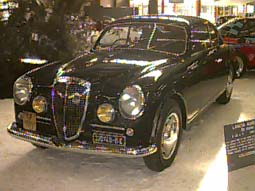 the
Aprilia again featured for several years, including class wins in the Mille
Miglia in 1947 and 1951.
the
Aprilia again featured for several years, including class wins in the Mille
Miglia in 1947 and 1951.
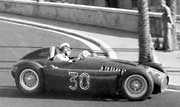 August
1953 the D24 made its debut at the Nurburgring 1000km, where both cars
retired, but success soon came with first and second in the Carrera Panamerica.
1954 saw the D24 gain Lancia's first overall win in the Mille Miglia, whilst
later in the year the next development, the D25 appeared. This had a very
short lifespan (1 race) since the decision had been taken to withdraw from
sports cars and enter Formula One.
August
1953 the D24 made its debut at the Nurburgring 1000km, where both cars
retired, but success soon came with first and second in the Carrera Panamerica.
1954 saw the D24 gain Lancia's first overall win in the Mille Miglia, whilst
later in the year the next development, the D25 appeared. This had a very
short lifespan (1 race) since the decision had been taken to withdraw from
sports cars and enter Formula One.
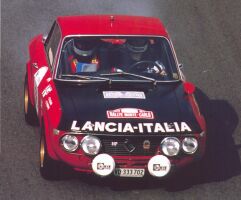 1960.
Various successes were gained with these and some support began to be forthcoming
from the factory. The Flavia began to be campaigned
in 1962 and the following year a group of drivers, led by Cesare Fiorio,
formed the HF Squadra Corse to compete in rallying. These drivers achieved
numerous wins, both overall and in class, before in 1965 the company absorbed
HF Squadra Corse and again officially entered motorsport.
1960.
Various successes were gained with these and some support began to be forthcoming
from the factory. The Flavia began to be campaigned
in 1962 and the following year a group of drivers, led by Cesare Fiorio,
formed the HF Squadra Corse to compete in rallying. These drivers achieved
numerous wins, both overall and in class, before in 1965 the company absorbed
HF Squadra Corse and again officially entered motorsport.
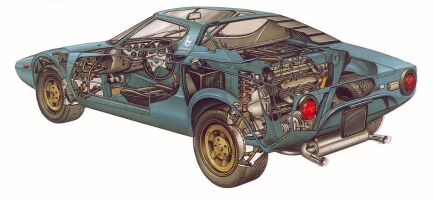 The
Fulvia, however, was getting old, and work had already started on a replacement,
the Stratos. Initially a concept car from Bertone,
much development resulted in a Ferrari V6 powered purpose built rally car
of which around 500 were built. Before homologation in October 1974 success
had already been achieved in some events open to prototypes, and this continued,
the Stratos winning its debut event, the Sanremo rally.
The
Fulvia, however, was getting old, and work had already started on a replacement,
the Stratos. Initially a concept car from Bertone,
much development resulted in a Ferrari V6 powered purpose built rally car
of which around 500 were built. Before homologation in October 1974 success
had already been achieved in some events open to prototypes, and this continued,
the Stratos winning its debut event, the Sanremo rally.
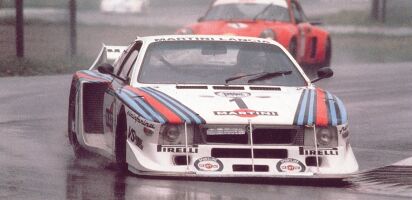 Fiat
having taken over in rallying, Lancia turned to sports car racing. Basically
a silhouette formula, the Beta Montecarlo was the
chosen tool. Heavily redesigned and fitted with a turbocharged 1400 engine,
the Beta Montecarlo turbo debuted at Silverstone in May 1979 and went on
to win its class in the championship. In 1980 the Beta Montecarlo turbo
won the manufacturers title and it repeated this, now in Martini colours,
in 1981.
Fiat
having taken over in rallying, Lancia turned to sports car racing. Basically
a silhouette formula, the Beta Montecarlo was the
chosen tool. Heavily redesigned and fitted with a turbocharged 1400 engine,
the Beta Montecarlo turbo debuted at Silverstone in May 1979 and went on
to win its class in the championship. In 1980 the Beta Montecarlo turbo
won the manufacturers title and it repeated this, now in Martini colours,
in 1981.
Going back to 1980 saw Lancia again developing
a rallycar. It had been decided that the Fiat 131 should be replaced by
a Lancia to compete in the new Group B which would start in 1982. The result
was the 037 or Rally. It debuted in 1982 with some
success, but 1983 saw it take the World Championship for Lancia. It continued
on in 1984 and 1985, but four-wheel-drive had stamped its authority on
rallying and the 037 could not keep up.
Lancia's response was the Delta
S4, which first appeared in 1985 and immediately won it's debut world
championship event, the RAC. 1986 saw several successes, but also tragedies;
in Portugal several spectators were killed, and on the Tour de Corse Toivonen
and Cresto died when they lost control of their 037. Lancia failed to clinch
the champioship, and Group B was banned. Lancia had already begun development
of the S4 replacement, the ECV, but this was never
to be used in action.
Fortunately for Lancia, they had introduced
the HF 4WD in 1986 and this formed the basis
of a competitor for the new Group A. 1987 saw Lancia win the manufacturers
title and it's drivers take the first three places in the drivers championship,
whilst for 1988 the first integrale appeared, again winning both the drivers
and manufacturers the championships. This was repeated in 1989 during which
year the first 16v integrales appeared. 1990 and 1991 both saw Lancia take
the manufacturers title, although the many different drivers split their
points and prevented any one from winning that championship.
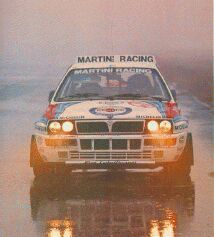 Lancia
officially withdrew from rallying at the end of 1991, but the Jolly Club
ran integrales in 1992 and again managed to take the manufacturers championship
- the sixth successive time !
Lancia
officially withdrew from rallying at the end of 1991, but the Jolly Club
ran integrales in 1992 and again managed to take the manufacturers championship
- the sixth successive time !
For various pictures of classic Lancia cars in both exhibitions and events see our galleries index.
For books on Lancia in motorsport try our online bookshop - in Association with Amazon.com & Amazon.co.uk.
Copyright © 2000 to 2008 CarsfromItaly